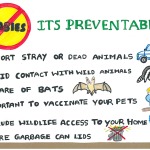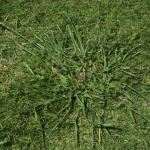Attention Administrators, Faculty, and Nurses!
Bonny Mayes, MA, Epidemiologist, Zoonosis Control Branch, Texas Department of State Health Services
The Texas Department of State Health Services would like to invite the kids at your school to participate in a Rabies Awareness & Prevention Poster Contest. Rabies is a viral disease that kills over 50,000 people every year around the world. Human deaths from rabies in the United States are very rare (approximately one death per year, almost exclusively due to rabies associated with bats). This is due to strict animal control laws, widespread pet vaccinations, and public health intervention in identified rabies-exposure cases. Rabies post-exposure prophylaxis is 100% effective when administered properly. However, the treatment is very expensive and requires multiple shots over a period of time.
Skunks and bats are the most commonly affected species in Texas. Private residences and school grounds are
the most common locations in Texas for exposure to rabid bats. Bat bites are not always noticeable and many people are unaware that exposure to bats poses a risk. Most of these rabies exposures are preventable through education. This is why we are encouraging school kids throughout Texas to become more aware about rabies and respecting bats and other wildlife from a distance. Children at your school can participate by entering a contest to design a poster promoting rabies awareness & prevention. There are prizes for students in Kindergarten through 8th grade, and artwork from top-ranking posters may be used for future state sponsored public health educational projects. Prizes are provided by the Zach Jones Memorial Fund www.zachjonesmemorial.org .
Please forward this information to the teachers in your school and encourage them to involve their students. This would be a perfect activity for schools participating in C-Scope as an informational text or procedural text assignment or as an excellent extra-credit project for an art or science class. Provided online is an information sheet for students and a teacher instruction sheet with details and an entry form www.dshs.state.tx.us/idcu/disease/rabies/information/contest . The deadline for poster submission is April 6, 2015. To see all the winners check out this link http://www.dshs.state.tx.us/idcu/disease/rabies/information/contest/winners/
Global Handwashing Day — practice safe handwashing practices this fall
The 7th annual Global Handwashing Day will be observed October 15, 2014. This observance increases awareness and understanding of handwashing with soap as an effective and affordable way to prevent disease around the world.
Handwashing with soap has an important role to play in child survival and health. Approximately 2.2 million children aged <5 years die each year from diarrheal diseases and pneumonia, the top two causes of death among young children globally (1). Handwashing with soap can reduce the incidence of diarrhea among children aged <5 years by 30% (2) and the incidence of respiratory infections by 21% (3).
Although persons around the world clean their hands with water, few use soap to wash their hands. Washing hands with soap removes bacteria much more effectively (4).
Additional information on Global Handwashing Day is available from CDC at http://www.cdc.gov/features/globalhandwashing . General handwashing information is available from at http://www.cdc.gov/handwashing . Information on water-related hygiene is available at http://www.cdc.gov/healthywater/hygiene/index.htm l.
References
- Liu L, Johnson HL, et al.; Child Health Epidemiology Reference Group of WHO and UNICEF. Global, regional, and national causes of child mortality: an updated systematic analysis for 2010 with time trends since 2000. Lancet 2012;379:2151–61.
- Ejemot RI, Ehiri JE, Meremikwu MM, Critchley JA. Hand washing for preventing diarrhoea. Cochrane Database Syst Rev 2008;(1):CD004265.
- Aiello AE, Coulborn RM, Perez V, Larson EL. Effect of hand hygiene on infectious disease risk in the community setting: a meta-analysis. Am J Public Health 2008;98:1372–81.
- Burton M, Cobb E, Donachie P, Judah G, Curtis V, Schmidt WP. The effect of handwashing with water or soap on bacterial contamination of hands. Int J Environ Res Public Health 2011;8:97–104.
Use of trade names and commercial sources is for identification only and does not imply endorsement by the U.S. Department of Health and Human Services.
References to non-CDC sites on the Internet are provided as a service to MMWR readers and do not constitute or imply endorsement of these organizations or their programs by CDC or the U.S. Department of Health and Human Services. CDC is not responsible for the content of pages found at these sites. URL addresses listed in MMWR were current as of the date of publication.
Fall Weed Control for Schools
Matt Elmore, Ph.D. – Assistant Professor and Extension Turfgrass Specialist
Control of grassy weeds, particularly perennial weeds like dallisgrass, has changed for landscape and athletic field managers in the wake of the MSMA ban. There is no longer one product that will control crabgrass, goosegrass, and dallisgrass, so we are forced to buy several different products and make separate applications to control these weeds. On top of that, these products are more expensive. Will there be a new product introduced that will ever truly replace MSMA? What options are available right now?
While there will be new turf herbicides introduced in the next 5-10 years, I don’t expect any game-changers. The drought in new herbicides is caused by the success of technology that engineered glyphosate tolerance in corn, soybean, and several other crops. Weed control with glyphosate was so cheap and easy that most other herbicides were rendered irrelevant. Declining sales meant declining revenues for agrochemical companies, and most major chemical companies drastically reduced their efforts to discover new herbicides. Fast-forward to the present, and glyphosate-resistant weeds are making old herbicides new again. Farmers now have to rely on several different herbicides and other weed control strategies (sound familiar?). Interest in herbicides besides glyphosate has reinvigorated the efforts of many agrochemical companies to discover new herbicides. However, if scientists are so lucky to discover a new herbicide molecule worthy of commercialization (only about 1 in 100,000 molecules screened are), the approval process is longer and more arduous than ever before. Much like the herbicides that have replaced MSMA, current experimental herbicides control a narrow spectrum of weeds. In short, do not expect a single new herbicide to replace MSMA and solve our weed control problems.
Effective weed control for the present and future should rely on combinations of herbicides, cultural practices,
and Mother Nature. To control perennial warm-season weeds like dallisgrass, fall herbicide applications are more effective than spring or summer applications. But fall is a long season; so when is the best time to make herbicide applications? In my previous job at the University of Tennessee, we found applications of Tribute Total (labeled in zoysiagrass and bermudagrass) or Celsius (labeled in St. Augustinegrass) provided good dallisgrass control when the first application was made when the average of the high and low daily air temperatures dropped below 70 °F for several days (probably mid to late September in North Texas) and another application was made 4-6 weeks later. We also observed control was improved further when a third application was made after spring greenup. So even though it is October and you have missed the window to make your first application for dallisgrass control, you can still a single application now before we hit winter and another in the spring.
Exactly why these fall herbicide applications work best is debatable. It could be that more herbicide is translocated to the roots during a fall application. But a common theme I have observed in successful fall application programs is that the dallisgrass or bermudagrass enters the winter before it recovers from herbicide applications. The timing of the last herbicide application is important. The last herbicide application should be made early enough in the fall that target weed is still growing, but late enough that it doesn’t recover before winter. These herbicide applications might leave dallisgrass in a weakened state, making it more likely to succumb to wintertime stresses. This might be analogous to a squirrel that cannot find enough acorns before the winter. Especially in a tough winter, will they survive?





 .
.